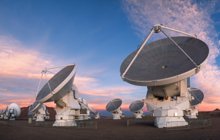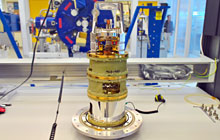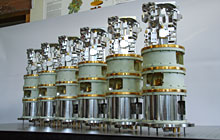ALMA Receiver Bands
 The Atacama Large Millimeter/submillimeter Array (ALMA) observes the Universe over a range of radio wavelengths within the millimetre and submillimetre region of the electromagnetic spectrum. To capture such a broad range of light from distant cosmic sources, each of ALMA’s 66 antennas are equipped with an arsenal of detectors, which are highly sensitive radio receivers. Each receiver type is sensitive to a particular "band", or range of wavelengths of the electromagnetic spectrum, and data can only be taken in one band at a time.
The Atacama Large Millimeter/submillimeter Array (ALMA) observes the Universe over a range of radio wavelengths within the millimetre and submillimetre region of the electromagnetic spectrum. To capture such a broad range of light from distant cosmic sources, each of ALMA’s 66 antennas are equipped with an arsenal of detectors, which are highly sensitive radio receivers. Each receiver type is sensitive to a particular "band", or range of wavelengths of the electromagnetic spectrum, and data can only be taken in one band at a time.
Nine of the planned ten receivers are installed and operating on each ALMA antenna, with the tenth currently being installed. These bands range from band 1, starting at wavelengths of 8.5 mm, to band 10, ending at 0.3 mm. Band 2 receivers have been used to produce "first fringes" but are not yet installed on all antennas.
|
ALMA Band |
Wavelength coverage (mm) |
Noise Temperature (K) Specification |
Frequency (GHz) |
Produced by |
Receiver Technology |
First light |
|
1 |
6–8.6 |
32 |
35 – 50 |
HEMT |
2021 |
|
|
2 |
2.6–4.5 |
47 |
67 – 116 |
OSO (Sweden) / NOVA (Netherlands) / INAF (Italy) / NAOJ (Japan) |
HEMT |
2023 |
|
3 |
2.6–3.6 |
60 |
84 – 116 |
HIA (Canada) |
SIS |
2009 |
|
4 |
1.8–2.4 |
82 |
125 – 163 |
NAOJ (Japan) |
SIS |
2013 |
|
5 |
1.4–1.8 |
105 |
163 – 211 |
SIS |
2016 |
|
|
6 |
1.1–1.4 |
136 |
211 – 275 |
NRAO (US) |
SIS |
2009 |
|
7 |
0.8–1.1 |
219 |
275 – 373 |
IRAM (France) |
SIS |
2009 |
|
8 |
0.6–0.8 |
292 |
385 – 500 |
NAOJ (Japan) |
SIS |
2013 |
|
9 |
0.4–0.5 |
261 |
602 – 720 |
NOVA (Netherlands) |
SIS |
2011 |
|
10 |
0.3–0.4 |
344 |
787 – 950 |
NAOJ (Japan) |
SIS |
2012 |
Band 1
These receivers allow ALMA to study the Universe in the longest wavelengths yet. In particular, these receivers can detect larger dust grains than the other ALMA bands, meaning band 1 is ideally suited to look at dust grain growth that contributes to e.g. planet formation. Band 1 allows astronomers to study distant galaxies and stars.
The development of the ALMA band 1 receivers was led by Taiwan’s Academia Sinica Institute of Astronomy and Astrophysics (ASIAA), accompanied by an international team comprising the National Astronomical Observatory of Japan (NAOJ), the University of Chile, the National Radio Astronomy Observatory (NRAO), the Herzberg Institute of Astrophysics in Canada and the National Chung-Shan Institute of Science and Technology in Taiwan. The University of Chile was also involved in the project, helping to develop and produce optical elements such as the lenses and horn antennas for the band 1 receivers.
Band 2
Band 2 presents the final band of the original ten planned at ALMA’s inception. It will allow important measurements of the cold interstellar medium, the tenuous mixture of matter and radiation that exists in the space between stars. In Band 2, ALMA will also be able to study the properties of dust in a variety of astronomical environments, from planet-forming discs to galaxies, and will be able to extend its capabilities to observing the distant Universe. Closer to home, Band 2 will enable observations of complex, heavy molecules in the local Universe. In particular, it will be crucial to probe the so called “carbon monoxide snow line” a region in planet-forming discs far away enough from the central stars for gas to condense. This is key for understanding the origins of planet formation and probe the precursors of life itself.
The development of Band 2 has been led by ESO and including partners at NAOJ, University of Chile, several European institutes and industry. The production of the Band 2 receiver cartridges will be undertaken by a consortium comprising the Netherlands Research School for Astronomy (NOVA), Chalmers University, Gothenburg, Sweden, and the Italian National Institute for Astrophysics (INAF). The National Astronomical Observatory of Japan (NAOJ) will contribute to the production and testing of receiver optics as an East Asia contribution to the ALMA Development Program.
The improved band 2 receivers represent a step towards the new generation of ALMA, anticipated for 2030. They will have better sensitivity and will be able to provide over 3.5 times more bandwidth than ALMA can currently achieve, while also benefiting observations in band 3. These upgrades will enable dramatic improvements in observation speed.
Band 3
Produced by the Herzberg Institute of Astrophysics in Canada, band 3 covers the longest wavelength range of the bands initially installed, between 2.6–3.6 mm.
Band 3 is of crucial importance to ALMA. It was used during the testing and commissioning of the antennas because its low frequency minimises the effects of atmospheric variations.
Within our galaxy, band 3 can be used to observe small-scale structure in cold gas clouds to search for new and exotic molecules (including carbon-based, pre-biotic molecules necessary for building life), and to detect molecular gas in discs around young stars. Beyond our own galaxy, band 3 can be used to image molecules in nearby galaxies at high resolution, to probe the cold interstellar medium of galaxies, and to peer into dust-obscured galaxies to study how stars form.
Band 3 has already helped to produce spectacular science results, such as finding an ingredient of life around infant Sun-like stars and observing the Sun.
Band 4
Developed by National Astronomical Observatory of Japan (NAOJ), band 4 covers a wavelength range of 1.8–2.4 mm. ALMA observations with the band 4 receiver provide data about interstellar matter and increase our understanding of how stars and galaxies form.
The very first target of band 4 was the protostar system IRAS16293-2422. About 400 light-years away, this system is surrounded by a large amount of gas that served as a seedbed for these stars. This test observation captured radio emission from carbon sulfide (CS) molecules contained in the gas. Many other interesting molecules also emit in the frequency range covered by the band 4 receiver, including formaldehyde (H2CO), deuterium compounds, and carbon chain molecules (a linkage of carbon atoms). These substances are found in large quantities in cold star-forming regions.
Band 5
 Band 5 saw first light in 2016 and extended ALMA’s coverage to a new range of the electromagnetic spectrum, seeing radio waves with wavelengths between 1.4–1.8 millimetres. This is a particularly exciting band because it allows astronomers to detect faint signals of water in the nearby Universe.
Band 5 saw first light in 2016 and extended ALMA’s coverage to a new range of the electromagnetic spectrum, seeing radio waves with wavelengths between 1.4–1.8 millimetres. This is a particularly exciting band because it allows astronomers to detect faint signals of water in the nearby Universe.
The European ALMA Programme Scientist, Leonardo Testi, explains the significance of band 5: “The band 5 receivers make it much easier to detect water, a prerequisite for life as we know it, in our Solar System and in more distant regions of our galaxy and beyond. They also allow ALMA to search for ionised carbon in the primordial Universe.”
The high sensitivity and angular resolution of ALMA allows astronomers to make detailed studies of water in a wide range of objects, including forming and evolved stars, the interstellar medium, and regions close to supermassive black holes. With band 5, ALMA can detect the emission from objects seen soon after the Big Bang, opening up the possibility of probing the earliest epoch of galaxy formation.
The band 5 receiver was developed by the Group for Advanced Receiver Development (GARD) at Onsala Space Observatory, Chalmers University of Technology, Sweden. The production of the 66 receivers for the ALMA observatory was done jointly by GARD and NOVA.
Band 6
Band 6 was produced by the National Radio Astronomy Observatory (NRAO) and covers the wavelength range of 1.1–1.4 mm. This allows it to study a variety of astronomical objects, such as the cold gas in nebulae, molecules on active comets, how red giant stars are heated and the afterglows of gamma-ray bursts, the most energetic explosions in the Universe. Along with band 3, astronomers have also used band 6 to reveal otherwise invisible details of our Sun, including a new view of the dark, contorted centre of a sunspot that is nearly twice the diameter of the Earth.
Band 7
Covering a wavelength range of 0.8–1.1 mm, the band 7 receivers were delivered by the Institut de Radio Astronomie Millimétrique (IRAM). At these wavelengths, astronomers can peer at the discs of gas and dust around newborn stars, see into star-forming clouds, and observe early galaxies that are bright in submillimetre wavelengths but obscured by dust in optical light. Band 7 has also been used for astronomy a bit closer to home, measuring the global wind patterns on Mars and the water content in the atmosphere of Venus.
Band 8
Developed by NAOJ, ALMA’s band 8 receivers span a wavelength range of 0.6–0.8 mm, opening another window to the Universe. This band allows ALMA to probe the emissions from various atoms and molecules, such as atomic carbon. Using ALMA’s band 8, astronomers took the world’s first interferometric image at 0.6 mm, synthesising the distribution of atomic carbon around a planetary nebula. Before this, all observations at this wavelength were made with single dish radio telescopes.
Band 9
 The band 9 receivers, produced by the Nederlandse Onderzoekschool voor Astronomie (NOVA), cover the wavelength range 0.4–0.5 mm. It is one of the highest frequency bands in the baseline ALMA project and offers some of the telescope's highest spatial resolution. The observations made possible by the band 9 receivers allow astronomers to study molecular clouds — the dense regions of gas and dust where new stars are being born — at higher temperatures and densities, and with higher angular resolution, thus complementing the longer wavelength bands.
The band 9 receivers, produced by the Nederlandse Onderzoekschool voor Astronomie (NOVA), cover the wavelength range 0.4–0.5 mm. It is one of the highest frequency bands in the baseline ALMA project and offers some of the telescope's highest spatial resolution. The observations made possible by the band 9 receivers allow astronomers to study molecular clouds — the dense regions of gas and dust where new stars are being born — at higher temperatures and densities, and with higher angular resolution, thus complementing the longer wavelength bands.
Astronomers have also used band 9 to study a "comet factory" around a new star, solving a long-standing planet formation mystery.
Six of the Band 9 receiver cartridges were delivered by NOVA (the Netherlands Research School for Astronomy) under contract to ESO for the ALMA project.
Band 10
The addition of the band 10 receivers extended ALMA’s vision fully into the realm of the submillimetre, the wavelengths of cosmic light that hold intriguing information about the cold, dark, and distant Universe. The effort to develop and produce band 10 was led by NAOJ and covers the wavelength range of 0.3–0.4 mm.
Band 10 brings to ALMA a broad range of capabilities, which — among other things — enables astronomers and planetary scientists to study and monitor temperature changes at different altitudes above the clouds of Uranus and other giant planets in our Solar System.